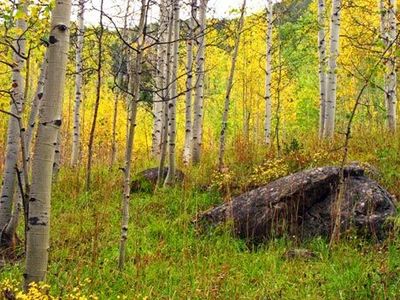|
Aspen Populus tremula ( Latin) Eadhadh (Gaelic Ogham) Aspris (Greek)
Black poplar Populus nigra White poplar P.alba Horrible grief, test tree or Aspen. Distinguished man or wood. Kinsman to the Birch, Aspen. Additional name for a friend. Book of Ballymote 1391 The Ogham name Eadhadh is most commonly associated with the aspen which is our only native woodland poplar. In North America it one of the oldest living organisms in the world as the same root stock is producing new shoots as it has done since the last ice age. In this country (UK) I have visited several aspen woodlands that have probably been created by one rootstock. In Utah (USA) one single aspen is thought to cover an area of 106 acres! In the British Isles however, the tree as an individual trunk only lasts 50-60 years before succumbing to heart rot. Its root system can live for much longer but is easily killed by other tree competitors as aspen is shade intolerant. This tree has a history therefore of benefitting from human interference as it grows well in a coppiced wood and especially when deer eat other tree species which would have otherwise suppressed it. Due to modern practices of planting and neglect the aspen is now in decline. Aspen does not easily reproduce from seed as the seed has to germinate within a week and needs to be exposed to prolonged immersion in water. The suckers it produces do vary and some experts claim to be able to tell the difference between male and female trees. One notable variation is the ‘giant aspen’ which grows in Suffolk and Essex to a much larger size than the usual species. Although Aspen will grow happily in wet soils that do not drain such as clay, it has been shown to deal more effectively with drought than ash or birch in the dry summers of 1975-6. It seems to avoid habitats where there is water movement such as plateau or valley alder woods, preferring more stagnant water habitats. Aspen is a tree of cold climates and with birch and sallow was one of the first trees to colonise Britain after the last ice age. Aspen has soft white wood which perishes easily and is poor building timber. Although ignored by the modern forester there are a surprising amount of references to it in medieval documents maybe due to the fact it grows well in coppice woods, and all timbers at that time were put to use. It was considered to be one of three non-coniferous softwoods (alder and black poplar being the other two), and therefore sometimes incorporated into building structures such as homes and windmills. As a specialist wood it can be used for carving and sculpture but was traditionally used for arrow shafts and clogs. In fact authorities were actively encouraging its use for arrow shafts in the 1400s due to a plentiful supply. Aspley Guise (Beds) and Stonham Aspal (Suffolk) are places named after the aspen and may indicate the tree was more common outside of a woodland habitat than it is today. Eadhadh , the Gaelic name for aspen, can be translated as ‘most buoyant of woods’ and indicates its use for the making of oars and paddles. Aspen flowers before it comes into leaf and is wind- pollinated. Aspen is known as the trembling tree ( P.tremula) and Christian lore states that the tree shudders at the thought that its wood was used for the crucifix. Other traditions equate the movement of its leaves ( due to its long flat leaf stalks) to speech and language. Some would say it is whispering or communicating with spirit or it can hear from afar and is stirred by what it hears. The tree therefore can be seen as an entrance to Other-worlds and used for divination. In the ancient Celtic system of the Ogham it speaks of the tree as the Test Tree and a later common phrase ‘to tremble like an aspen’ could be related to this. To face fears and highlight your weaknesses takes great strength, are you prepared to tremble like an aspen to move on in your life? Oscar, a Celtic warrior from Irish literature, had to kill the High King against impossible odds to protect his kinsman. He is likened to an aspen and described as ‘no way daunted despite terrible injury’. In our own lives the fear is more likely to be standing up to what we believe in or being ourselves no matter what the outcome. Are you prepared to face loneliness, humiliation or loss of material wealth to be true to yourself? Shields have also been made from this tree and the Greek word for aspen (aspris) means ‘wood to make shields’ reminding us of its connection to warriors and going forth. This tree can therefore help us find the courage to face our fears as well as testing us before moving on. Aspen is the knowledge that you are never too advanced to feel fear and shake with grief. This is the realisation that will take you to a place of protection and an advancement of knowledge. Our other native poplar is the black poplar (P.nigra) referred to in Medieval documents as ‘popeler’. It is a large non-woodland tree and once one of the most common farmland trees in Eastern England. It is now rare and only occasionally seen. The black poplar has distinctive rugged boughs once used to make cruck frames. These are curved timbers used to hold up roofs especially in medieval barns. The black poplar stands, a black outline against the sky with large heavy curved branches sweeping down to the ground, oozing sap known as balsam indicative of the Goddess of Death. When a new tree was planted at docking time a lamb’s tail was buried under it as a gift to the Goddess. Ointments can be made from the buds of this tree to treat bruises, inflammations and gout. The sap or balsam from the tree can be used as incense. The last poplar tree I would like to mention is the white poplar ( P.alba). It stands in stark contrast to the black poplar with its wonderful silvery downy leaves which flutter in the wind that cannot fail to uplift one’s spirits. Like white willow this is the species most commonly associated with witches, especially medieval French witches. There is a debate as to whether this tree is a native to Britain. Often thought to have been introduced to this country in the 1600s. It is referred to in documents dating from 1200-1300 as ‘abel’. Whether it is an early introduction or a true native we may never know. This tree has a leaf with 5 points symbolic of witches and is said that the balsam was used to help witches fly at night when rubbed onto their bodies. The white leaves are said to move you into a trance, give the gift of eloquence when placed under the tongue and connect the tree to the moon. Its distinctive white bark can be used to make a rather pleasant tea which is used for pain relief. To receive our monthly newsletter packed with even more information on tree, plants and British traditions please subscribe HERE.
0 Comments
Leave a Reply. |
Details
Poetry of flowersJoin me to explore the flora of the British Isles on this blog. My intention is to attempt to capture the unique quality and beauty of each species of flower, tree or shrub. For every species featured I will be growing many more wildflowers to celebrate the joy of their existence, their intrinsic conservation value and bewildering array of uses. For nearly 30 years I have noted, studied and explored wildflowers in the field much to the patience of the walker beside me. To share this passion is a heartfelt plea to respect, preserve and care for all British Wildflowers no matter how common they seem. Archives
February 2024
Categories |



 RSS Feed
RSS Feed
